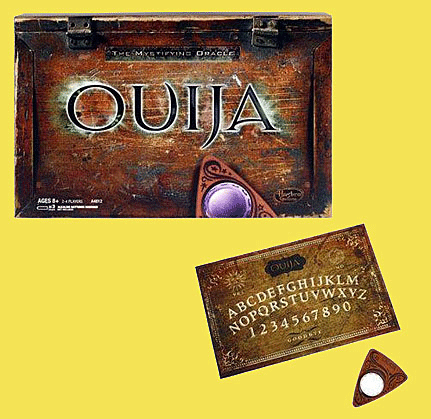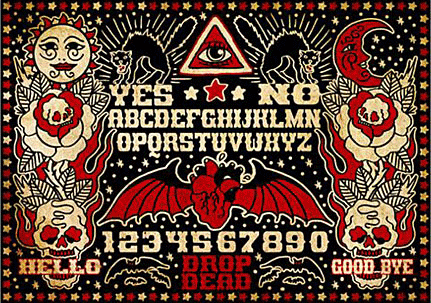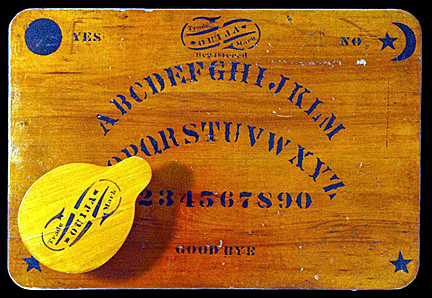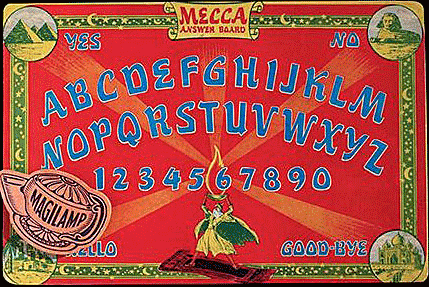|
Communicating with the Dearly
Departed
________________________________________________________
QUESTION:
 I
recently saw a Ouija Board for sale at a Saturday flea market at my
local fire company. It brought back a lot of pleasant memories. When I
was a kid, one of my friends got a Ouija Board. Every Saturday
afternoon, we would play with it for hours, asking it questions about
life and potential relationships. I realize it was only a toy, but can
you tell me how Ouija Boards originated and how come they became so
popular? I
recently saw a Ouija Board for sale at a Saturday flea market at my
local fire company. It brought back a lot of pleasant memories. When I
was a kid, one of my friends got a Ouija Board. Every Saturday
afternoon, we would play with it for hours, asking it questions about
life and potential relationships. I realize it was only a toy, but can
you tell me how Ouija Boards originated and how come they became so
popular?
Thanks,
Georgia
______________________________________________________
ANSWER:
 Although
Ouija Boards gained popularity from the 1960s to the 1980s, they
actually originated in 1890 during the Age of Spiritualism. Although
Ouija Boards gained popularity from the 1960s to the 1980s, they
actually originated in 1890 during the Age of Spiritualism.
The year was 1890 and the age of Spiritualism was in full swing. Founded
on the belief that people could communicate with the dearly departed,
the movement often depended on "mediums" who fell into a trance and
spoke for the dead, or unconsciously wielded pens or pencils to spell
out messages termed called "automatic" writings. Ordinary people
gathered around the kitchen table and invited the disembodied to rock it
to spell out coded messages, or employed a "dial plate" imprinted with
numbers and letters and fitted with a free-floating pointing device a
spirit might manipulate to deliver a message from the other side.
But each of these conduits to the Netherworld had its limitations.
Tables were cumbersome, mediums were difficult to find, and automatic
writing was as impossible to read as a doctor's prescription. Then a
popular refinement to automatic writing called the “planchette"—French
for "little plank"—came into being. This palm-sized, heart-shaped piece
of wood supported by three wheeled casters, usually made of bone, had a
pointed end with a hole in which a person could insert a pencil. This
allowed the device to glide over a piece of paper leaving a trail of
legible notes from the dearly departed.

 In
1886, an article appeared from the new Associated Press about the
“talking board,” a new phenomenon taking over the spiritualists’ camps
in Ohio, with letters, numbers and a planchette-like device to point to
them. Charles Kennard of Baltimore, Maryland read it and sensed there
was money to be made. In 1890, he gathered together a group of four
other investors—including Elijah Bond, a local attorney, and Colonel
Washington Bowie, a surveyor—to start the Kennard Novelty Company to
exclusively make and market these new talking boards. None of the men
were spiritualists, but they knew a great business opportunity. In
1886, an article appeared from the new Associated Press about the
“talking board,” a new phenomenon taking over the spiritualists’ camps
in Ohio, with letters, numbers and a planchette-like device to point to
them. Charles Kennard of Baltimore, Maryland read it and sensed there
was money to be made. In 1890, he gathered together a group of four
other investors—including Elijah Bond, a local attorney, and Colonel
Washington Bowie, a surveyor—to start the Kennard Novelty Company to
exclusively make and market these new talking boards. None of the men
were spiritualists, but they knew a great business opportunity.
 The
first "talking board" produced by the Kennard Novelty Company would not
only field answers from the Other Side, but also become the canvas for a
unique form of American pop art for the next 70 years. Regardless of
being named after a fabled Moroccan city spelled "Oujda" or "Oujida" or
maybe from the French and German words for yes and no, "oui".and ja,"
its title became "Ouija" in English. Over time, the boards themselves
became pure Americana. The
first "talking board" produced by the Kennard Novelty Company would not
only field answers from the Other Side, but also become the canvas for a
unique form of American pop art for the next 70 years. Regardless of
being named after a fabled Moroccan city spelled "Oujda" or "Oujida" or
maybe from the French and German words for yes and no, "oui".and ja,"
its title became "Ouija" in English. Over time, the boards themselves
became pure Americana.
By 1892, the Kennard Novelty Company had seven factories—two in
Baltimore, two in New York, two in Chicago, and one in London. And by
1893, the other two original investors kicked Kennard and Bond out. By
this time, William Fuld, who started as a worker a the new company and
rose to become foreman and a stockholder, was running the company. In
1897, Bowie leased the rights to manufacture the Ouija board to William
and his brother Isaac.
Fuld ran the company for the next 35 years, and it was his Ouija Board
that exists in one form or another today. After he died from a fall in
1921, his children took over the business, manufacturing the family
boards until 1966 when they sold out to Parker Brothers.
 Almost
before the ink could dry on Kennard's original patent, shops across the
country began turning out almost exact copies of his talking board with
enough variation to satisfy the law. Others simply borrowed the basic
design elements of the original and added graphics that ranged from
cartoon-like to grandiose. Through the 1960s hundreds of companies
manufactured talking boards, their designs often reflecting the times. Almost
before the ink could dry on Kennard's original patent, shops across the
country began turning out almost exact copies of his talking board with
enough variation to satisfy the law. Others simply borrowed the basic
design elements of the original and added graphics that ranged from
cartoon-like to grandiose. Through the 1960s hundreds of companies
manufactured talking boards, their designs often reflecting the times.
Popular board themes included the Middle East, Egypt and the Zodiac, but
board makers placed all sorts of emblems and icons on their creations.
There was a Mitchie Manitou board that celebrated an arcane spirit of
the Algonquin Indians, a Halloween board with witches, an Age of
Aquarius board in the 1960s, and a New Age board in the 1970s. Artistry
aside, the appeal of the talking board remained its dual nature as a
parlor game, a toy, and a device for communicating with the dearly
departed.

As a parlor game the talking board was the hula-hoop of its time. The
instructions on the back of most boards said that two persons—ideally of
the opposite sex—were to sit across from each other in a quiet, darkened
room, supporting the board between them on their knees, and hope for
something magical. And for some, that undoubtedly happened.
<
Back to Readers Ask Archives
Next Article >
|
